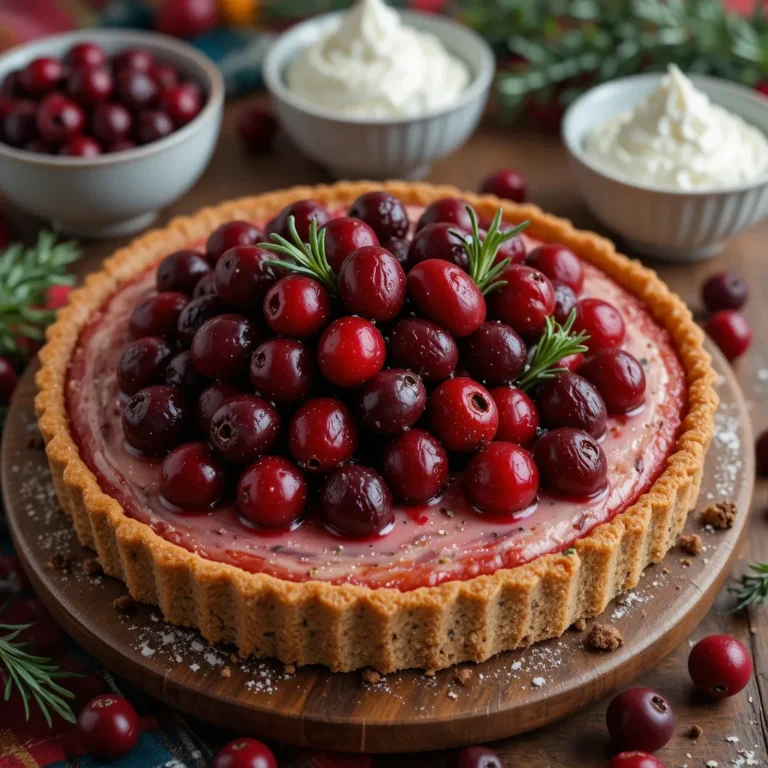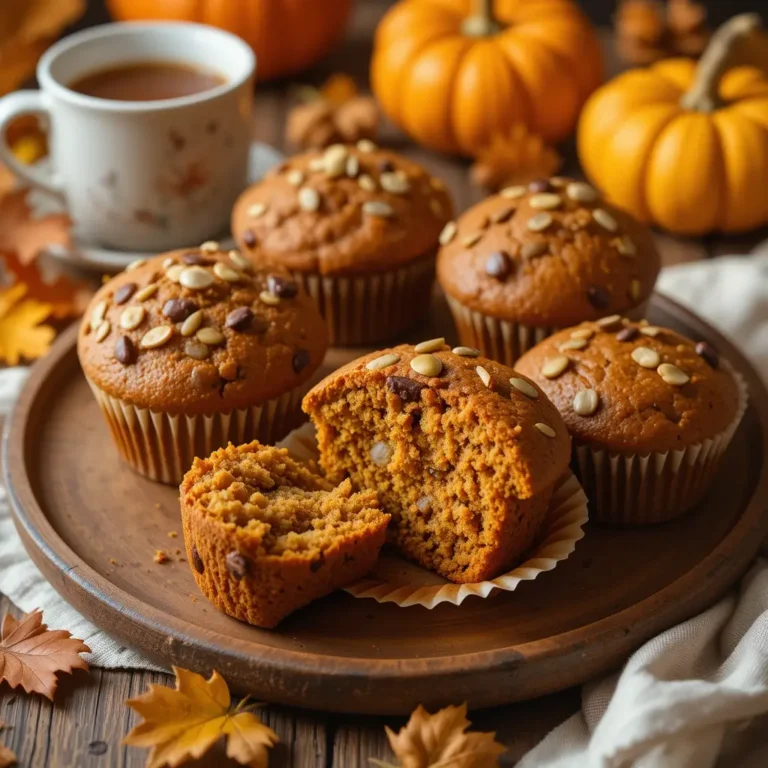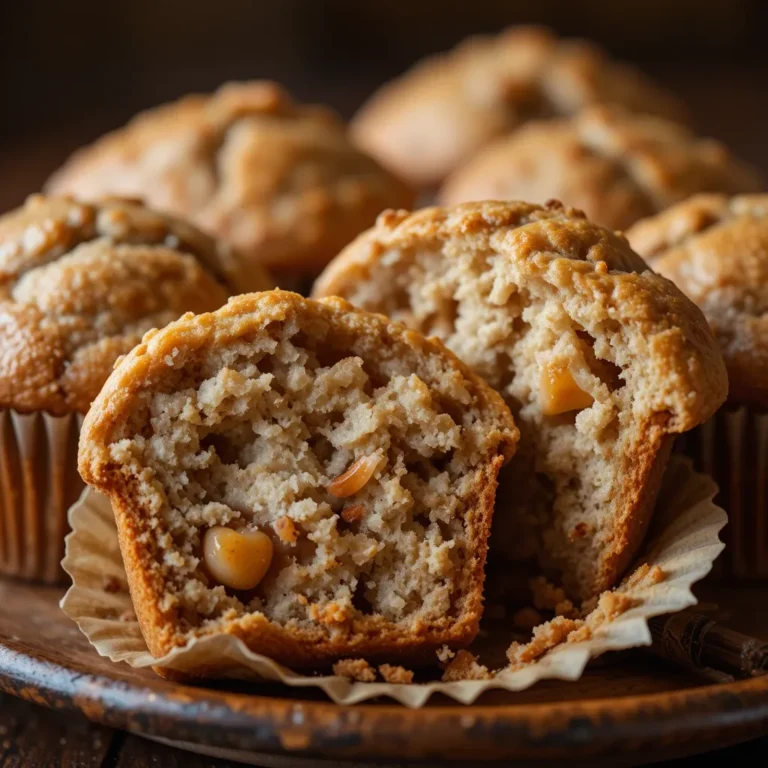Homemade Cranberry Orange Cake Recipe – Must Try
There’s something magical about a cranberry orange cake fresh from the oven—tart berries bursting through tender, citrus-kissed crumb, filling your kitchen with the most irresistible aroma. This showstopper combines sweet and tangy flavors in perfect harmony, creating a dessert that’s neither too heavy nor too light.
Whether you’re hosting Sunday brunch or need a stunning holiday centerpiece, this cake delivers every single time. It reminds me of my lemon blueberry pound cake but with a festive twist that feels like celebration on a plate. Trust me, once you taste this beautifully moist cranberry orange cake, you’ll be making it all season long!
What is Cranberry Orange Cake?
Ever wonder why cranberry and orange became such an iconic duo? It’s like they were meant to be together—the bright, zingy orange cuts through the cranberry’s natural tartness, creating pure magic. My grandmother always said “the way to a man’s heart is through his stomach,” and honestly, this cake proves her right every time.
The name says it all: fresh cranberries nestled in an orange-scented cake that tastes like sunshine and winter holidays had a delicious baby. Ready to fall in love?

Why You’ll Love This Cranberry Orange Cake
The Perfect Balance of Sweet and Tart
This isn’t your average cake. The cranberry orange cake hits that sweet spot where tart cranberries play beautifully against the sweet, buttery cake base. Fresh orange zest adds an aromatic brightness that makes each bite feel alive and exciting. The jewel-toned cranberries create gorgeous pockets of flavor throughout, and when you slice into it, those ruby-red berries look absolutely stunning against the golden crumb.
Budget-Friendly Baking at Its Finest
Making this cranberry orange cake at home costs a fraction of what you’d pay at a bakery. Fresh cranberries are incredibly affordable, especially during their peak season, and you probably have most other ingredients sitting in your pantry right now. Skip the expensive bakery cakes and create something even better yourself—your wallet and taste buds will thank you.
Simple Ingredients, Spectacular Results
The beauty of this recipe lies in its simplicity. Basic pantry staples transform into something extraordinary when combined with fresh cranberries and bright orange flavor. A vanilla glaze or simple dusting of powdered sugar takes it over the top without requiring fancy decorating skills. If you loved my classic vanilla bundt cake, you’ll adore this festive variation that brings so much more personality to the table. Don’t wait—grab those cranberries and let’s get baking!
How to Make Cranberry Orange Cake
Quick Overview
This cranberry orange cake is surprisingly straightforward to make, even if you’re not a baking expert. The batter comes together in one bowl, and folding in the cranberries takes just seconds. What makes this recipe special is how the orange zest infuses every bite with citrusy brightness while keeping the cake incredibly moist. The texture is tender and buttery with a delicate crumb that practically melts in your mouth.
Time Breakdown:
- Prep Time: 15 minutes
- Bake Time: 45-55 minutes
- Cooling Time: 30 minutes
- Total Time: About 1 hour 40 minutes
Key Ingredients for Cranberry Orange Cake
For the Cake:
- 2 cups all-purpose flour
- 1 ½ teaspoons baking powder
- ½ teaspoon baking soda
- ½ teaspoon salt
- ¾ cup unsalted butter, softened
- 1 cup granulated sugar
- 3 large eggs, room temperature
- 2 teaspoons vanilla extract
- Zest of 2 large oranges
- ½ cup fresh orange juice
- ½ cup sour cream or Greek yogurt
- 2 cups fresh cranberries (or frozen, unthawed)
- 2 tablespoons flour (for tossing cranberries)
For the Orange Glaze:
- 1 cup powdered sugar
- 2-3 tablespoons fresh orange juice
- 1 teaspoon orange zest
- Pinch of salt
Pro tip: Keep those cranberries frozen until you’re ready to toss them in flour—this prevents them from bleeding into the batter and turning everything pink!
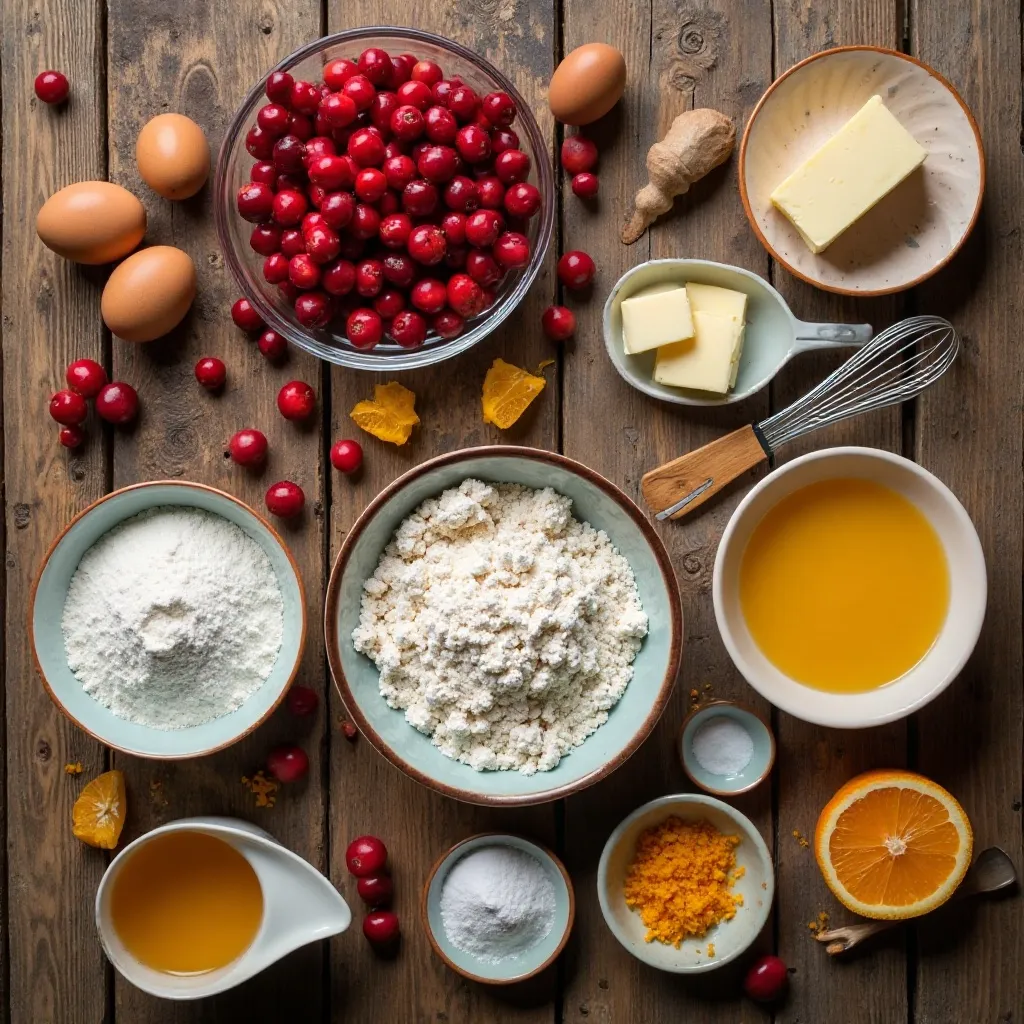
Step-by-Step Instructions
Step 1: Prepare Your Pan and Preheat
Preheat your oven to 350°F (175°C). Grease a 9-inch round cake pan or bundt pan generously with butter, then dust it with flour, tapping out any excess. This step is crucial for ensuring your beautiful cake releases perfectly. I learned this the hard way when half my cake stuck to the pan during my first attempt!
Step 2: Mix Your Dry Ingredients
In a medium bowl, whisk together the 2 cups of flour, baking powder, baking soda, and salt. Set this aside. This ensures your leavening agents are evenly distributed throughout the cake, giving you that perfect rise.
Step 3: Cream Butter and Sugar
In a large mixing bowl, beat the softened butter and sugar together using an electric mixer on medium-high speed for about 3-4 minutes. You’re looking for a light, fluffy texture that’s almost white in color. This incorporates air into your batter, creating that tender crumb we all love.
Step 4: Add Eggs and Flavorings
Add the eggs one at a time, beating well after each addition. Mix in the vanilla extract and orange zest. The orange zest is where so much flavor lives, so don’t skip it! Your kitchen should already smell amazing at this point.
Step 5: Alternate Wet and Dry Ingredients
With your mixer on low speed, add the flour mixture in three additions, alternating with the orange juice and sour cream in two additions. Start and end with the flour mixture. Mix until just combined after each addition—overmixing creates a tough, dense cake. The batter should look thick and creamy.
Step 6: Prepare the Cranberries
In a small bowl, toss your cranberries with 2 tablespoons of flour. This coating helps prevent them from sinking to the bottom of your cake. Gently fold the coated cranberries into your batter using a rubber spatula. Be gentle here—you don’t want to crush those beautiful berries.
Step 7: Bake to Perfection
Pour the batter into your prepared pan and smooth the top with a spatula. Bake for 45-55 minutes, or until a toothpick inserted into the center comes out clean or with just a few moist crumbs. The top should be golden brown and spring back when lightly touched. If you’re using a bundt pan, it might take closer to 55-60 minutes.
Step 8: Cool and Release
Let the cake cool in the pan for 15 minutes on a wire rack. This prevents it from breaking apart when you remove it. Run a knife around the edges, then invert onto the wire rack to cool completely. Patience is key here—I know it’s tempting to dig in immediately!
Step 9: Make the Orange Glaze
While your cake cools, whisk together the powdered sugar, orange juice, orange zest, and a pinch of salt. Start with 2 tablespoons of juice and add more if needed to reach a pourable consistency. You want it thick enough to coat the back of a spoon but thin enough to drizzle beautifully.
Step 10: Glaze and Serve
Once your cake is completely cool, drizzle the orange glaze over the top, letting it cascade down the sides. If you’re feeling fancy, garnish with extra orange zest or a few fresh cranberries. Let the glaze set for about 10 minutes before slicing.
What to Serve Cranberry Orange Cake With
This versatile cake works beautifully for multiple occasions. Serve it for breakfast or brunch alongside a hot cup of coffee or Earl Grey tea—the citrus notes complement tea perfectly. For an afternoon treat, pair it with vanilla ice cream or freshly whipped cream.
During the holidays, it makes a stunning dessert when served with spiced cider or champagne. The tart cranberries cut through rich holiday meals beautifully. I also love serving thin slices with a cheese board featuring creamy brie or goat cheese—the sweet-tart cake balances the richness wonderfully.
For a complete brunch spread, set it out with scrambled eggs, bacon, and a fresh fruit salad. It’s substantial enough to feel satisfying but not so heavy that you’ll need a nap afterward!
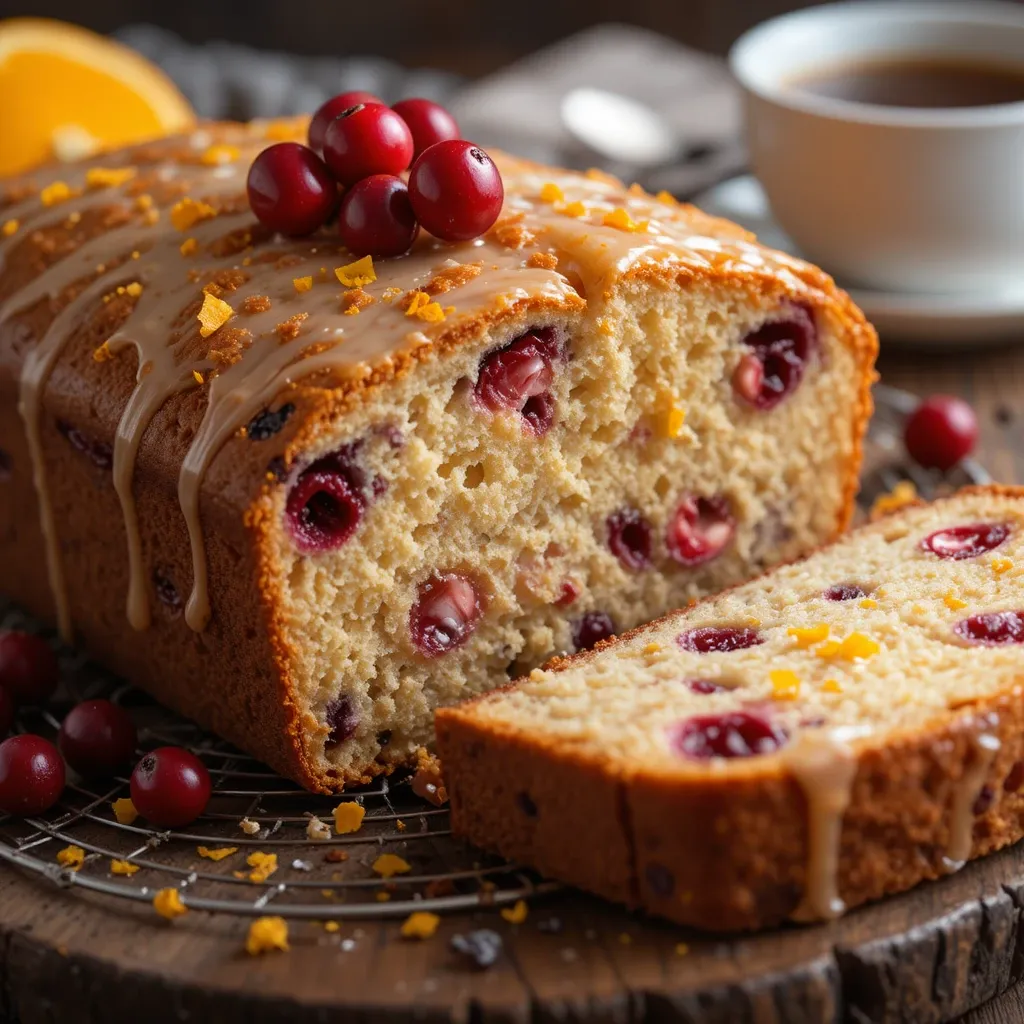
Top Tips for Perfecting Cranberry Orange Cake
Use Fresh Orange Zest for Maximum Flavor
Don’t even think about using bottled orange juice or dried zest. Fresh is absolutely essential here. The oils in fresh orange zest contain so much more flavor than anything from a bottle. Zest your oranges before juicing them, and use a microplane for the finest, most aromatic results.
Room Temperature Ingredients Are Key
Cold eggs and sour cream won’t incorporate smoothly into your batter, leading to a dense, uneven texture. Set everything out 30 minutes before baking. If you forget, place eggs in warm water for 5 minutes—they’ll warm up quickly.
Don’t Overmix the Batter
Once you add flour, mix only until you can’t see any white streaks. Overmixing develops gluten, which makes your cake tough and chewy instead of tender and delicate. Think of it like this: about 20-30 seconds of mixing after adding each flour addition is plenty.
Test for Doneness Properly
Ovens vary wildly, so start checking at 45 minutes. Insert a toothpick into the center—it should come out clean or with a few moist crumbs, never wet batter. If the top is browning too quickly, tent with foil for the last 15 minutes of baking.
Frozen Cranberries Work Great
No need to thaw frozen cranberries—in fact, don’t! Frozen berries hold their shape better and are less likely to bleed into the batter. Just toss them with flour while still frozen and fold them into your batter.
Storing and Reheating Tips
Store your cranberry orange cake in an airtight container at room temperature for up to 3 days. The cake actually gets more moist and flavorful on day two as the orange flavor permeates throughout. Just make sure it’s completely cool before covering, or condensation will make it soggy.
For longer storage, refrigerate the cake for up to one week. Bring slices to room temperature before serving, or warm them slightly in the microwave for 10-15 seconds to restore that fresh-baked feel.
This cake freezes beautifully! Wrap individual slices or the whole cake tightly in plastic wrap, then aluminum foil. Freeze for up to 3 months. Thaw overnight in the refrigerator, then bring to room temperature. I recommend freezing it without the glaze and adding fresh glaze after thawing for the best appearance.
If you want to serve it warm (which is absolutely delicious), reheat slices in a 300°F oven for about 5-7 minutes, or microwave for 15-20 seconds. A warm slice with vanilla ice cream melting over the top? Pure heaven.
Common Baking Mistakes to Avoid
Not Greasing the Pan Properly
This is the number one reason cakes stick. Use soft butter (not cooking spray for this recipe) and really get into every nook and cranny, especially if using a bundt pan. Dust with flour after greasing, tapping out excess. Some bakers even use a mixture of equal parts flour, oil, and shortening as a foolproof pan coating.
Adding Cranberries Without Coating Them
Uncoated cranberries sink to the bottom and can create a dense, soggy layer. The flour coating gives them something to cling to as the batter bakes. This simple step makes a huge difference in distribution.
Opening the Oven Door Too Early
I know curiosity kills, but opening the oven before the cake is at least 40 minutes in can cause it to collapse. The structure hasn’t set yet, and the temperature drop can ruin your cake. Be patient and trust the process!
Cutting Into a Warm Cake
A hot cake is fragile and will crumble or tear when sliced. Let it cool completely if you want clean, beautiful slices. If you absolutely must eat it warm (I understand the temptation!), wait at least 20-30 minutes and expect messier slices.
Using Old Baking Powder or Baking Soda
These leavening agents lose potency over time. If yours are more than 6 months old, do a quick test: add baking powder to hot water (it should fizz vigorously) or baking soda to vinegar (same reaction). If there’s no reaction, toss them and buy fresh—your cake won’t rise properly with old leaveners.
Frequently Asked Questions
Can I use dried cranberries instead of fresh?
Fresh or frozen cranberries work best for this recipe because dried cranberries have a different texture and sweetness level. Dried cranberries won’t provide those bursts of tart flavor that make this cake special. If you must use dried, soak them in orange juice for 30 minutes first, drain well, then toss with flour before folding into the batter.
Why did my cranberries sink to the bottom?
This usually happens when you skip tossing them in flour or if your batter is too thin. The flour coating helps suspend the berries throughout the cake. Also, make sure you’re not overmixing after adding the cranberries, as this can thin out the batter too much.
Can I make this cake ahead of time?
Absolutely! This cranberry orange cake tastes even better the next day as the flavors meld together. Bake it up to 2 days ahead, store it covered at room temperature, and add the glaze a few hours before serving for the freshest look.
What can I substitute for sour cream?
Greek yogurt works perfectly as a 1:1 substitute and provides the same tangy flavor and moisture. Full-fat yogurt works best. You can also use buttermilk, though you’ll need to reduce the orange juice slightly to maintain the right batter consistency.
How do I know when the cake is done?
Insert a toothpick or cake tester into the center of the cake. It should come out clean or with just a few moist crumbs clinging to it. The cake should also pull away slightly from the sides of the pan, and the top should spring back when gently pressed.
Can I make this as muffins or cupcakes?
Yes! This batter makes excellent muffins or cupcakes. Fill muffin cups about ¾ full and bake at 350°F for 18-22 minutes. You’ll get approximately 18-20 muffins from this recipe. They’re perfect for breakfast or lunchboxes!
My cake is too dense. What went wrong?
Dense cake usually results from overmixing the batter, using cold ingredients, measuring flour incorrectly (packing it into the cup), or old leavening agents. Make sure to spoon flour into your measuring cup and level it off, don’t pack it down. Mix just until combined after adding flour.
Can I double this recipe?
You can double the recipe, but I recommend baking in two separate pans rather than one large pan. The baking time will be similar. Alternatively, make one cake, then repeat the process for a second one—it’s easier to manage and ensures consistent results.
Nutrition Information
| Nutrient | Per Slice (1/12 of cake) |
|---|---|
| Calories | 285 |
| Total Fat | 12g |
| Saturated Fat | 7g |
| Cholesterol | 70mg |
| Sodium | 180mg |
| Total Carbohydrates | 42g |
| Dietary Fiber | 1g |
| Sugars | 28g |
| Protein | 4g |
| Vitamin C | 15% DV |
Note: Nutrition information is approximate and will vary based on specific ingredients used and slice size.
Final Thoughts
This cranberry orange cake has become my go-to recipe whenever I need something that looks impressive but doesn’t require advanced baking skills. The combination of tart cranberries and bright orange creates a flavor profile that feels special without being overly complicated.
What I love most is how forgiving this recipe is—it works beautifully for beginner bakers but produces results that look bakery-professional. The gorgeous ruby cranberries peeking through each slice, the moist tender crumb, and that glossy orange glaze make it photograph beautifully too (hello, Instagram!).
Whether you’re baking for Thanksgiving, Christmas, a winter brunch, or just because Tuesday needs cake, this cranberry orange cake delivers every time. It’s become such a staple in my kitchen that I buy extra bags of cranberries during their peak season and freeze them just so I can make this cake year-round.
Give this recipe a try, and I promise you’ll understand why it’s gotten so many five-star reviews from my readers. That first bite—with the tart cranberry, sweet cake, and bright orange dancing on your tongue—is absolutely unforgettable. Happy baking, friends!


